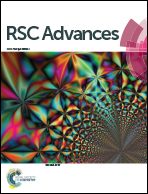Surface properties of ceria synthesised using Triton-X based reverse microemulsions†
Abstract
The effect of the tail length of Triton-X surfactants on the surface properties of ceria prepared by means of reversed micelles and Ce(OiPr)4 has been systematically studied. Generally, solids with increased surface areas (up to 136 m2 g−1) were synthesised. It was shown that the tail length strongly affects the surface characteristics. Further studies were carried out using UV-Vis, ATR-FTIR, XRD and TGA/DSC studies of the precursor gels as well as N2-isothermal adsorption BET, XRD, FT-IR, UV-Vis diffuse reflectance and SEM investigations of the final solids samples. An interaction mechanism between the ceria precursor molecules and the polar tail of the reversed Triton X micelles and the formation of ceria (CeO2) particles in the aqueous nucleus of the reversed microemulsions is proposed.



 Please wait while we load your content...
Please wait while we load your content...